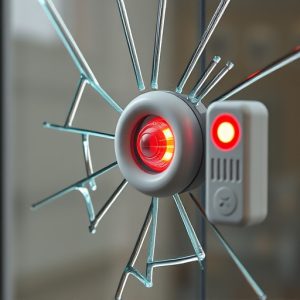Securing Homes with Glass Break Alarm Sensors: Detection, Installation, and Maintenance Tips
Glass break alarm sensors are critical components of modern security systems, adept at detecting the…….
Glass break alarm sensors are critical components of modern security systems, adept at detecting the acoustic signature of breaking glass through advanced signal processing. These sensors use highly sensitive microphones to identify the unique sound patterns of shattered glass, minimizing false alarms and providing timely alerts when unauthorized entry is attempted through glass surfaces. They are an integral part of smart home security, working in conjunction with other devices like motion detectors and door/window contacts to offer a comprehensive protective measure for homes, retail spaces, educational institutions, public venues, and beyond. Installation is straightforward, requiring careful placement to avoid false alarms from sources like air conditioning units. Regular maintenance and testing ensure their effectiveness, making them a reliable deterrent against intruders and a vital element in maintaining security and privacy within diverse environments. For optimal performance, consider the sensor's environment, including factors such as background noise and glass types, to calibrate it accurately within your overall security strategy. Basic troubleshooting steps can address most issues without professional help, ensuring these sensors continue to function as an essential part of your home or commercial security system.
Explore the multifaceted role of window break sensors in fortifying home security. This comprehensive article elucidates the detection mechanisms and diverse applications of glass break alarm sensors, delving into their sophisticated technology and practical installation process for homeowners. Compare their efficacy against other security measures, gain insights on upkeep and troubleshooting to maintain optimal functionality, and understand why a glass break alarm sensor is an indispensable component in modern home defense systems.
Understanding Glass Break Alarm Sensors: Detection Mechanisms and Applications
Glass break alarm sensors are critical components in security systems designed to detect the sound of breaking glass, signaling potential intrusion or hazardous conditions. These sensors employ sophisticated technology to differentiate between the frequency and pattern of glass fracturing and other sounds, ensuring a high degree of accuracy. They operate primarily through microphones that are highly sensitive to the specific acoustic signature associated with glass breakage. When activated by a noise matching this profile, the sensor triggers an alarm, alerting occupants and security personnel to the breach.
The detection mechanisms behind glass break alarm sensors involve advanced signal processing algorithms capable of distinguishing between the unique sound of breaking glass and other similar noises, such as glass being intentionally shattered or unrelated events like windows being cleaned or construction activities. These sensors are not only used in residential and commercial security systems but also in critical infrastructure to protect against vandalism or accidental breakages that could compromise safety or integrity. They can be found integrated into smart home systems, where they contribute to a layered defense strategy that includes door and window contacts, motion detectors, and surveillance cameras. Their applications extend across various sectors, including residential homes, retail establishments, schools, public venues, and any other space where protecting against unauthorized entry is paramount.
The Technology Behind Glass Break Alarm Sensors: How They Work
Glass break alarm sensors are a critical component in home and commercial security systems, designed to detect the sound of breaking glass. These sophisticated devices utilize advanced microphone technology capable of distinguishing between the acoustic signature of glass breaking and other sounds. Upon activation, they analyze audio frequencies emitted when glass is compromised, comparing these patterns against a database of known glass breakage signals. This process allows the sensor to differentiate between the specific sound of glass shattering and regular ambient noise or other disturbances, effectively reducing false alarms.
The technology behind these sensors involves the use of both hardware and software algorithms that are fine-tuned to recognize the unique spectral characteristics and temporal patterns associated with the breakage of glass. They are often integrated into smart security systems, where they work in conjunction with cameras, motion detectors, and other sensors, providing a comprehensive layer of protection. The sensitivity and accuracy of these sensors can be adjusted to accommodate various environments, ensuring their effectiveness across different settings. This adaptability, combined with their low-profile design, makes glass break alarm sensors an indispensable tool for maintaining security and peace of mind.
Installing a Glass Break Alarm Sensor: Step-by-Step Guide for Homeowners
When enhancing your home security system, a glass break alarm sensor can serve as an effective deterrent against intruders. This device is designed to detect the sound of breaking glass, triggering an immediate alarm and alerting you to potential unauthorized entry. To install a glass break alarm sensor successfully, follow this step-by-step guide tailored for homeowners.
Begin by selecting the optimal location for your sensor. Position it near windows or other vulnerable points where intrusion is most likely. Ensure that the sensor has an unobstructed view of the glass to accurately capture the sound without interference. Once you’ve determined the ideal spot, affix the sensor securely to a flat surface using the provided adhesive mounting bracket or screws, depending on the installation options available for your model. Make sure the sensor is at least 18 inches away from any air conditioning units that might produce similar vibrations to those caused by breaking glass.
After mounting the sensor, connect it to your home security system according to the manufacturer’s instructions. Test the sensor by performing a dry run; this involves simulating the sound of breaking glass within a controlled environment. The sensor should activate the alarm, indicating that it is properly sensitive and functioning correctly. If the alarm does not sound during the test, adjust the sensitivity settings as necessary or reposition the sensor to avoid false alarms from common household sounds like window fans or construction noise. Regularly test your system to ensure that the glass break alarm sensor remains sensitive and effective, providing you with peace of mind and an additional layer of security for your home.
Comparing Glass Break Alarm Sensors with Other Security Devices: Advantages and Considerations
Glass break alarm sensors represent a critical component in home and commercial security systems, offering a swift response to potential intrusions. Unlike traditional motion detectors, these sensors are specifically designed to identify the acoustic signature of breaking glass, activating an alarm immediately upon detection. This early warning feature is particularly advantageous as it can deter burglars before they even enter the premises. Additionally, integration with other security devices such as cameras and silent alarms allows for a comprehensive security approach, enhancing the overall efficacy of the system.
When comparing glass break alarm sensors to other security devices like contact sensors on windows and doors or CCTV cameras, they offer unique benefits. For instance, glass break sensors can detect attempts to breach windows or glass surfaces even if the intrusion is subtle or silent. This sensitivity makes them an effective layer of defense against stealthy intrusions that might evade traditional sensors. Moreover, their ability to differentiate between breaking glass and other noises minimizes false alarms, ensuring that security personnel can prioritize genuine threats. However, it’s important to consider the installation environment and the sensor’s specifications, as factors like ambient noise levels and the types of glass present can influence its performance. Proper placement and calibration are essential to maximize their effectiveness within a broader security framework.
Maintenance and Troubleshooting Tips for Your Glass Break Alarm System
When maintaining your glass break alarm sensor, regular inspection is key to ensuring its optimal functionality. Begin by testing the sensor periodically to confirm it detects the frequency of glass breaking as intended. This can be done by mimicking the sound of breaking glass using a tool that emits a similar high-frequency vibration, ensuring the sensor responds and alerts accordingly. Dust and debris can affect the sensor’s performance, so clean it gently with a soft cloth or brush. If your system has a battery, monitor its charge level and replace it as per the manufacturer’s guidelines to prevent false alarms or sensor failure due to power issues.
Should your glass break alarm sensor malfunction, troubleshooting can often resolve the problem without the need for professional assistance. If the sensor fails to activate, check its connections and ensure they are secure and free from corrosion. In cases where the sensor is mounted near windows that receive regular cleaning, consider temporarily disconnecting it during cleaning activities to avoid accidental triggering. If the system continues to give false readings or fails to detect glass breakage, inspect the sensor for any signs of damage, and if present, replace the unit as damages can impair its sensitivity and detection capabilities. Additionally, consult the user manual for troubleshooting steps specific to your model, as some systems may have unique features or quirks that require special attention during maintenance and repair.


